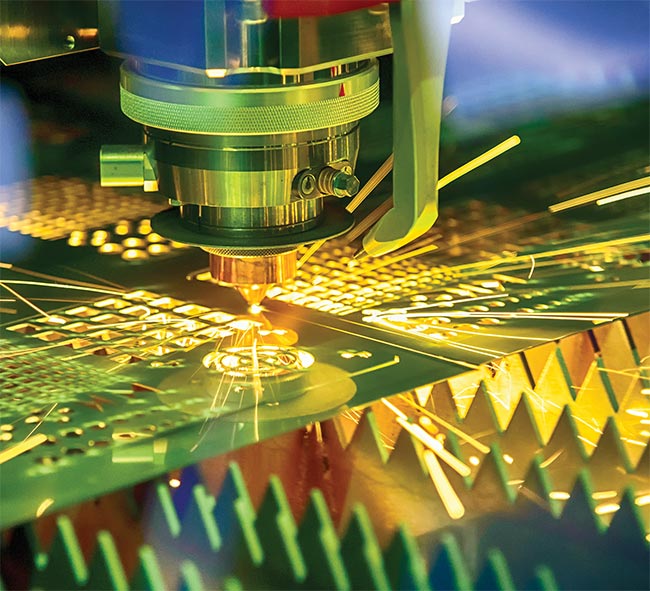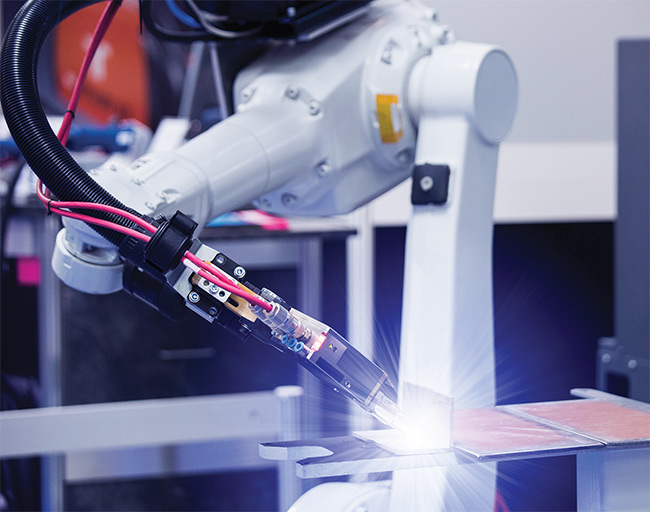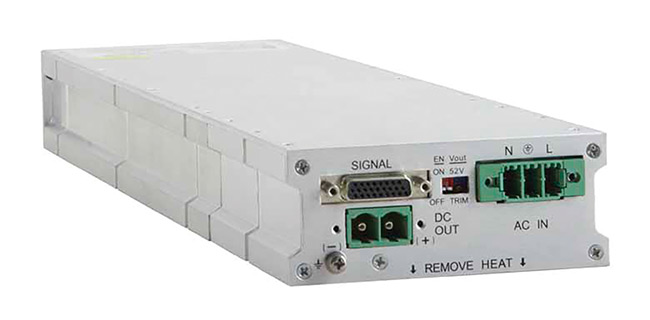GOPAL MITRA, ABB POWER CONVERSION
Pulsed lasers have become increasingly common in manufacturing and engineering applications over the past few decades. These powerful tools enable industrial engineers to execute various materials processing tasks, such as cutting, marking, welding, cleaning, and texturizing. Lasers are often able to perform all of these tasks with more precision than waterjet, plasma, or electromechanical processes, an ability that yields increased efficiency and reliability and enables more complex designs.

Power supplies that are used to support laser functions must have the capacity and deep duty cycle necessary to support rapidly distributed high-voltage pulse loads. Courtesy of ABB Power Conversion.
Despite the significant advantages that laser systems offer in industrial environments, their design and use come with challenges. One of the most pressing of these obstacles is building and implementing power supplies that can support these systems’ expansive and varied demands at scale. Still, systems designers often view power supply as an afterthought to meeting the demands of the application. However, power capabilities form the foundation of any laser’s functionality and are inextricably linked to its performance.
Back to the basics
Although the specific needs and demands of a laser’s power supply vary based on the application, most end uses typically demand a few basic qualities from the power supply: specifically, consistency, adaptability, and responsiveness.
Consistency is crucial to sustaining precision. To be a reliable source of coherent light, a pulsed laser must repeatedly excite a gain medium to emit at a specific wavelength. This process turns light into directed energy, which facilitates a particular function that a manufacturer desires.
Depending on a laser’s intended application, pulses may need to occur upward of 1000× each second, and each pulse must precisely meet specifications for pulse width, frequency, slew rate, and amplitude each and every time.
It’s that “every time” bit that can be problematic for power supply designers. This might feel counterintuitive, but the key to consistency in power distribution is often adaptability.
While it’s important that a laser’s power supply is tailored to the tasks that the tool will be performing, a certain amount of adaptability or flexibility from that supply is crucial. Though each pulse must be delivered precisely, what this means can change during the equipment’s operation. Therefore, the power supply must be able to support pulses at various loads and under different ongoing demands.
For this reason, laser power supplies
should include highly responsive monitoring capabilities. Agility and responsiveness are crucial to the ongoing performance of a laser. Without these qualities, the equipment’s lifespan can be cut considerably.

To build an effective power supply, designers need to consider the laser’s load demand, power density, operating environment, efficiency requirements, and cooling needs. Courtesy of ABB Power Conversion.
Pulse loading is an incredibly demanding process for laser tools. Activating coherent light requires the repeated delivery of large electrical loads over extended periods. Integrated monitoring capabilities allow power supplies to adapt to a laser tool’s changing demands to increase its longevity. The power supplies that are used to support laser functions must have the capacity and deep duty cycle necessary to support rapidly distributed high-voltage pulse loads for hours at a time or longer.
Things to consider: The laser
So, a good power supply for laser applications is able to balance the qualities of consistency, adaptability, and responsiveness. But achieving this balance is easier said than done. Finding it requires engineers to carefully weigh a wide range of considerations. Though all pulsed laser applications share these three key qualities, each system build has specific parameters that define optimal functionality. These include:
• Pulse width, or the duration of each pulse.
• Pulse frequency, or the number of pulses emitted in a one-second period.
• Slew rate, or the maximum rate of change in voltage over a given period.
• Pulse energy, which is integral to a pulse’s optical power over time and
is defined by the total energy content of each pulse.
• Load capacitance, or the external circuit capacitance in parallel with the conduction material.
• Load inductance, or the amount of resistance acting against the power source.
Further complicating the process are the ways in which these factors interact. Designers cannot build a power supply based on any single, isolated factor. The system’s efficacy is about the whole, not the sum of its parts. This is both a blessing and a curse.

Powering laser functions requires incredibly large energy transfers. But the limited space in industrial processes puts a premium on the footprint of power conversion and distribution equipment. Evaluating the power capacity of rectifiers relative to their form factor can help guide engineers’ decisions toward the most power-dense option. Courtesy of ABB Power Conversion.
On one hand, it allows engineers to fine-tune their builds to increase efficiency, optimize pulse parameters, and promote longevity. On the other, choosing even one ill-fitting component can be
detrimental to the depth of the laser’s cut, its precision, and the speed of its workflow.
Things to consider: The power
With the wide range of power components available to designers, choosing the right tool for each job can be difficult — even when the designers know how the end device must function. Considering the
following power-supply-specific factors can help guide engineers toward more
effective, efficient, and optimized builds.
Environment. Pollution and debris from the environments in which industrial lasers operate can affect the lifespan and functionality of the tool. Depending on the materials in use in the facility, laser designers may need to completely or partially seal the cabinets that house a laser’s power supply and other components.
Power density. Powering laser functions requires incredibly large energy transfers. But the demand for increasingly compact systems means the space available for power conversion and distribution equipment is shrinking. Evaluating the power capacity of rectifiers relative to their form factor can help guide engineers’ decisions toward the most power-dense option.
Efficiency. A laser’s efficiency is generally in the 15% to 40% range, depending on its intended application and power system specifications. This means that power supplies may at times need to carry the capacity to deliver up to 6× more power than the laser puts out. For example, a laser intended to cut wood may need a 1000-W load to support a 400-W pulse. The remaining energy is wasted in the conversion, distribution, and activation processes. Finding the most efficient components is therefore crucial to a successful application.
Cooling needs. All power supplies need cooling to mitigate the heat that results from energy waste. However, the relatively low efficiency of lasers’ overall functioning makes the use of cooling equipment even more important to their operation. Their significant heat losses, paired with their need for semi- or fully sealed cabinets — which can restrict airflow and exacerbate stress on the system — can make the job of air-cooling laser power supplies more problematic. Therefore, designers may want to explore using fanless, conduction, or liquid cooling options to increase efficiency and reliability.
Load demand. When selecting rectifiers for pulsed laser systems, designers may want to find equipment that prioritizes reliable, high-frequency loading. Some prefabricated and validated options include firmware that can be optimized to provide the transient response and capacitance necessary to handle the needs of high-power laser applications, thereby supporting longer lifespans. Choosing an option with tested and validated firmware to support the demanding loads created by pulsed laser systems can help to ensure an optimized distribution system.
The power of partnership
Although most people involved in the
design, manufacturing, and use of industrial lasers understand that well-calibrated power supplies are important to overall function, the disconnect between power engineers, laser engineers, and operators remains large. To bring about the next era of laser design and manufacturing, laser and power specialists will need to work together to build customized power supplies that take all of the above system and application factors into account.
Laser manufacturers have traditionally integrated power supplies into their
products, but interdisciplinary partnerships with power designers are beginning to take shape. Now more than ever, industrial laser manufacturers are working alongside power specialists to design modular, custom-built power supplies. Enlisting power conversion and distribution experts to aid in the design process
is helping manufacturers to reduce maintenance costs, boost the reliability of their products, and optimize laser performance for even the most demanding applications.
With the foundation for joint progress laid, the expansion and continuation of these collaborations will facilitate the next generation of efficient, reliable, and responsive lasers.